

Metabolic Treatment of Cancer: Intermediate Results of a Prospective Case Series. + Author Affiliations Correspondence to: L.

Schwartz, Ecole Polytechnique Laboratoire LIX, 91128 Palaiseau, France. 9422db96ab6ec3e20b4230a3c5398a82a370. The Long-Term Survival of a Patient With Stage IV Renal Cell Carcinoma Following an Integrative Treatment Approach Including the Intravenous α-Lipoic Acid/Low-Dose Naltrexone Protocol - Burton M. Berkson, Francisco Calvo Riera, 2018. Case History Kidney cancer is among the 10 most common cancers in both men and women.
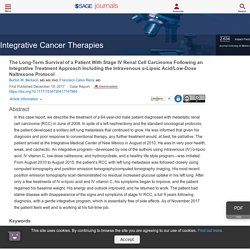
The lifetime risk for developing kidney cancer, which is higher in men than in women, is about 1 in 63 (1.6%), a rate that has been rising since the 1990s.1 According to the American Cancer Society, the 5-year survival rate for stage IV renal cancer is just 8%.1 The patient subject of this report is a 64-year-old man with a history of fatigue, atherosclerotic vascular disease, prostatitis, joint pains, and myalgias. He was diagnosed with renal cell carcinoma (RCC) with metastases to the lung in early June 2008 after he started to feel vague flank discomfort followed soon afterwards by gross hematuria. He immediately presented to the local emergency room. Figure 1. Figure 2. After a left nephrectomy, his hematuria resolved, and the patient was started on bevacizumab by his local oncologist for 4 months with no positive results.
Unfortunately, the patient’s condition continued to worsen. Figure 3. A combination of alpha lipoic acid and calcium hydroxycitrate is efficient against mouse cancer models: Preliminary results. Authors: Laurent Schwartz Mohammad Abolhassani Adeline Guais Edward Sanders Jean-Marc Steyaert Frederic Campion Maurice Israël View Affiliations Affiliations: Service de Radiothérapie Hôpital Pitié-Salpétrière, bd. de l'Hôpital, 75013 Paris, France. laurent.schwartz@polytechnique.edu Published online on: May 1, 2010 Pages: 1407-1416 Metrics: Total Views: 4266(Spandidos Publications:4266 | PMC Statistics: 0) Metrics: Total PDF Downloads: 1848 (Spandidos Publications: 1848 | PMC Statistics: 0 )

(PDF) Tumor regression with a combination of drugs interfering with the tumor metabolism: Efficacy of hydroxycitrate, lipoic acid and capsaicin. Metabolic Treatment of Cancer: Intermediate Results of a Prospective Case Series. Glycolysis, Fermentation and the Citric Acid Cycle - Biol 230 Master - Confluence. This tutorial describes the breakdown of glucose into carbon dioxide and water.

In cells, this occurs in a stepwise fashion that starts in the cytoplasm and ends in the mitochondria. As chemical bonds are broken, energy is captured and stored in the form of high-energy molecules. There are three major stages in the breakdown of glucose. In the first stage, six-carbon sugars are cleaved into three-carbon sugars. In the second stage, these three-carbon sugars are further broken down in two alternate pathways: one that requires oxygen and one that does not.
By the end of this tutorial you should know: Figure 1. All cells require some source of energy to carry out their normal functions. This tutorial describes the catabolism of glucose, the most common simple sugar found in both animals and plants. The Glycolytic Pathway Is Tightly Controlled - Biochemistry - NCBI Bookshelf. Regglyc. File. Metformin directly acts on mitochondria to alter cellular bioenergetics.
Although metformin is widely used in the treatment of type II diabetes, and is under investigation for possible utility in cancer treatment, its effects on cellular and mitochondrial metabolism are incompletely understood.
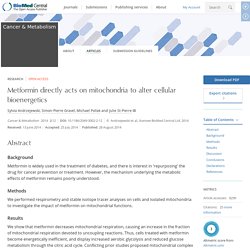
We show that metformin acts directly on mitochondria to inhibit complex I-mediated mitochondrial respiration and citric acid cycle functions. In agreement with our results obtained with isolated mitochondria, cells treated with metformin display reduced glucose metabolism through the citric acid cycle, in addition to showing an overall decrease in mitochondrial respiration, and a shift in favor of uncoupling reactions. As a result, mitochondrial metabolism becomes energetically inefficient, and cells compensate for this limitation in ATP production by increasing aerobic glycolysis (Figure 7).
Our results confirm that mitochondria are key targets of metformin despite reports suggesting cytoplasmic actions [11, 13].
Is the Warburg Effect the Cause or the Effect of Cancer: A 21st Century View? Citric acid: Carcinogenic Potency Database. Citric acid (CAS 77-92-9)SMILES, InChI and Structure are below.
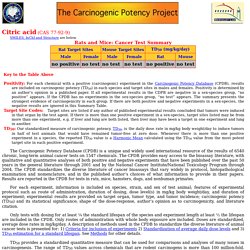
Rats and Mice: Cancer Test Summary Key to the Table Above Positivity:For each chemical with a positive (carcinogenic) experiment in the Carcinogenic Potency Database (CPDB), results are included on carcinogenic potency (TD50) in each species and target sites in males and females. Positivity is determined by an author’s opinion in a published paper. Does DCA Cure Cancer? ISIS Report 10/04/12 A common chemical seems just short of the latest miracle cure for cancer, but its implications for our basic understanding of cancer may be far more important Dr.
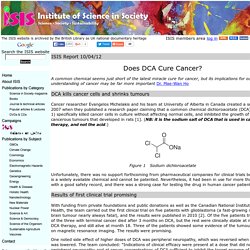
Mae-Wan Ho DCA kills cancer cells and shrinks tumours. The Overnight Cancer Cure: MMS, DMSO, MSM, Citric Acid & Colloidal Silver (Cancer Forum) 10/28/2008 1286815. The Overnight Cure For Cancer (OCC) - Version 2 by R.
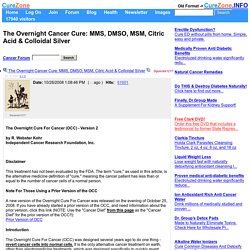
Webster KehrIndependent Cancer Research Foundation, Inc. Disclaimer This treatment has not been evaluated by the FDA. The term "cure," as used in this article, is the alternative medicine definition of "cure," meaning the cancer patient has less than or equal to the number of cancer cells of a normal person. Note For Those Using a Prior Version of the OCC. A patient with glioblastoma multiforme who improved after taking citric acid orally.
Cancertutor. When citric acid causes cancer: Agios Pharmaceuticals and IDH inhibitors. Agios Pharmaceuticals (AGIO) is at the forefront of drug development against a central path of cancer’s evolution – its metabolism.

Mb 0420. PNAS 2012 Bénéteau 20071 6. Patent US20070248693 - Nutraceutical composition and method of use for treatment / prevention of cancer - Google Patents. [0001] This application is a continuation in part of application Ser.
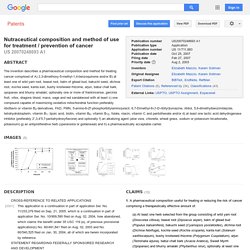
No. 11/233,279 filed on Sep. 21, 2005, which is a continuation in part of application Ser. No. 10/909,590 filed on Aug. 02, 2004, how abandoned, which claims the benefit under 35 USC 119 (e), of previous provisional application(s) No. 60/491,841 filed on Aug. 02, 2003 and No. 60/540,525 filed on Jan. 30, 2004, all of which are herein incorporated by reference. . [0002] The U.S. government has certain rights to this invention as federal support was provided for by NIH Grant NCRR 03020. Cancer treatment - Babikian, Yousef Haik.
The present invention relates generally to a composition for the treatment of malignant tumors and, more specifically, to its use in a method for the treatment of carcinomas and sarcomas. Breast cancer is a malignant abnormal cell growth in the breast. Cancer cells may spread to other areas of the body (called metastasis). Fibrocystic changes (e.g., formation of cysts, scar tissue) may cause benign (i.e., noncancerous) lumps in the breast. In women, breast cancer is the second most common type of cancer and the second leading cause of cancer-related deaths. One in eight women in the United States will develop breast cancer during their lifetimes. Approximately 200,000 women in the United States are diagnosed with breast cancer each year, and the disease causes about 40,000 deaths annually. The incidence of breast cancer rises after age 40.
Untitled. Cancer generated lactic acid: Novel therapeutic approach. Cancer-generated lactic acid: a regulatory, immunosuppressive metabolite? Hypercitricemia in Human Cancer. Factors concerned in Pathogenesis and Treatment. A study of the citric acid cycle in certain tumour tissues. THE ROLE OF CITRIC ACID IN THE PHYSIOLOGY OF THE PROSTATE. 3. LACTATE/CITRATE RATIOS IN BENIGN AND MALIGNANT PROSTATIC HOMOGENATES AS AN INDEX OF P... Citric Acid in Human Prostatic Secretion and Metastasizing Cancer of Prostate Gland. Cc 0333.